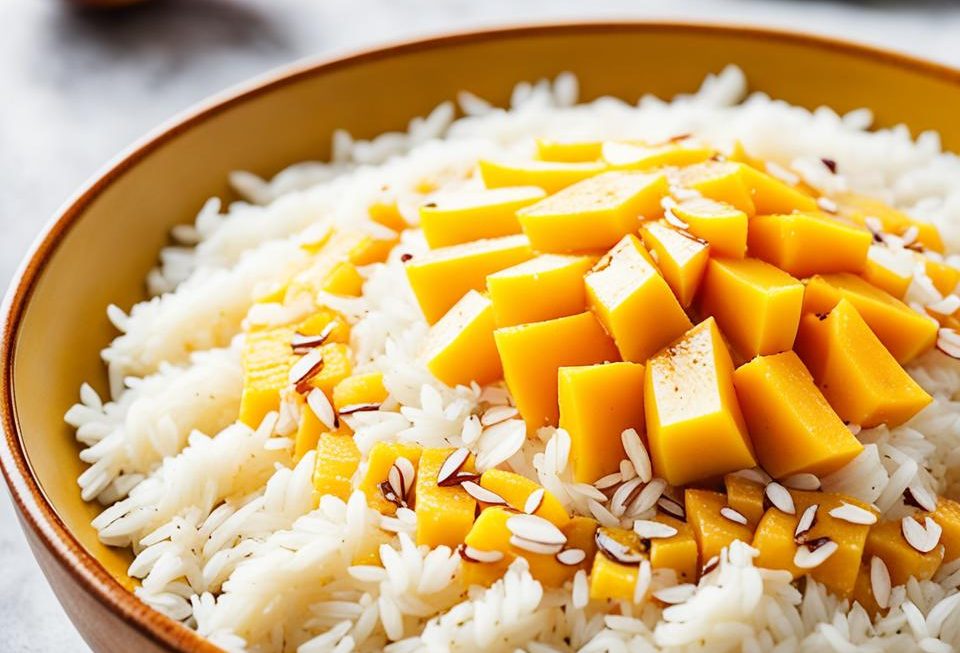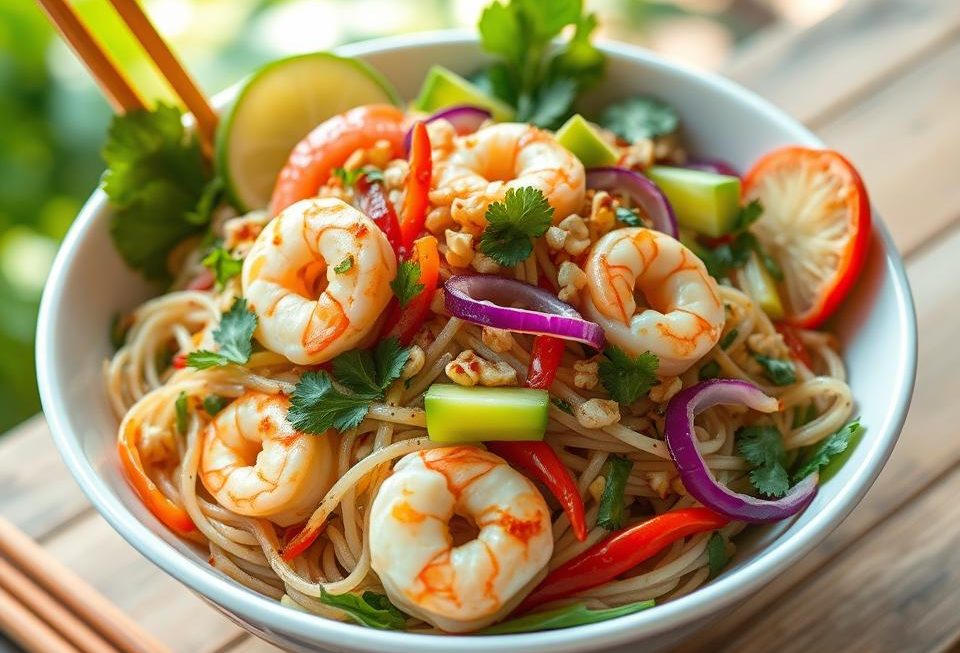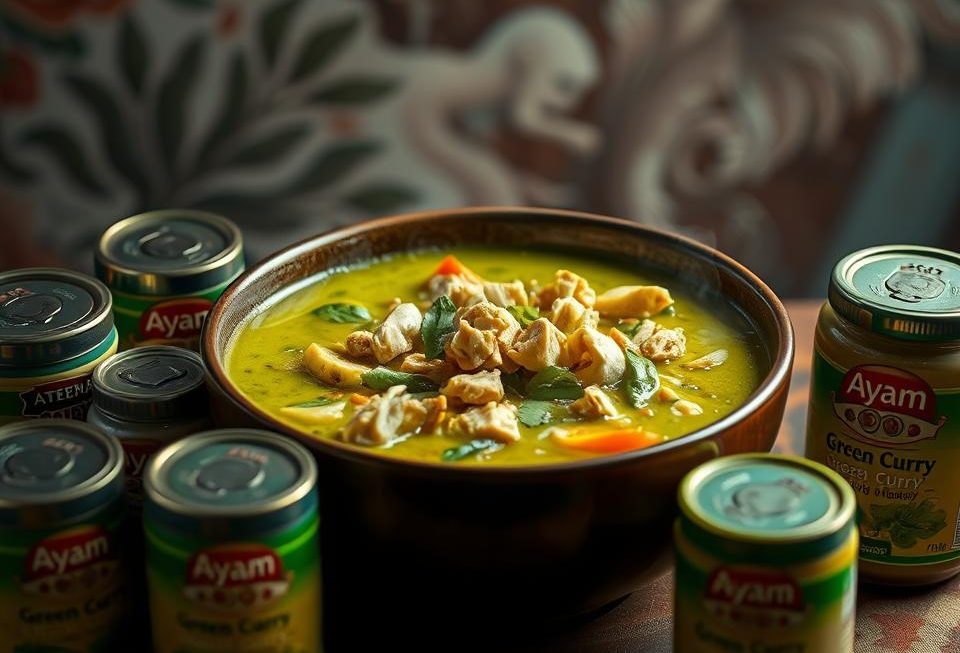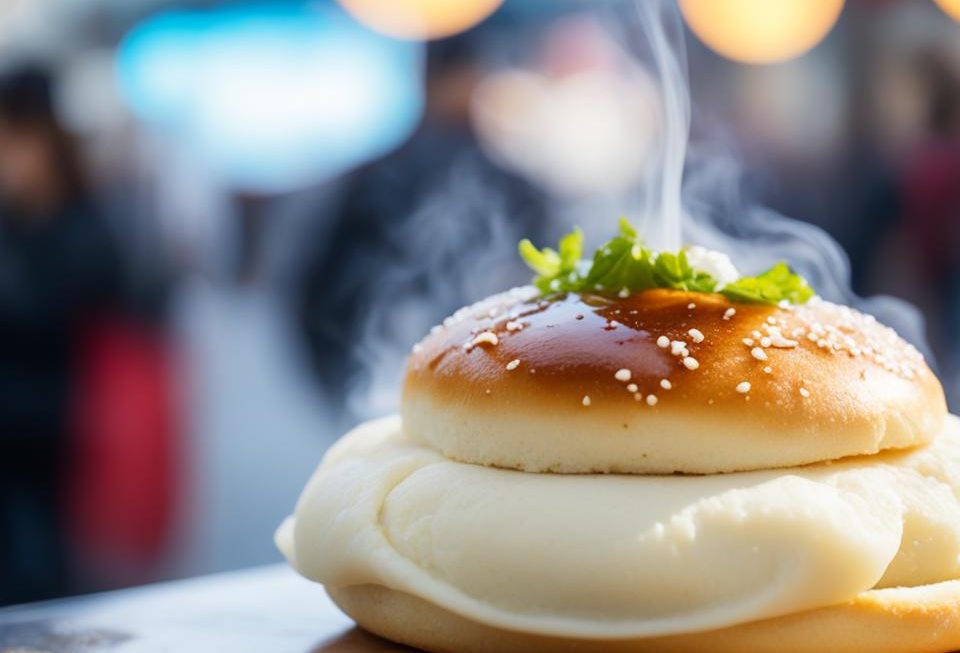In this article, we will share with you the secrets to making the best mango sticky rice, a beloved and authentic Thai dessert. This classic recipe is both easy to prepare and irresistibly delicious, making it a popular choice for dessert lovers around the world.
Mango sticky rice, also known as “khao niao mamuang” in Thai, originated in Thailand and has become one of the country’s most famous and beloved traditional desserts. Its combination of sweet and sticky rice with ripe mango is a true culinary delight.
Read more interesting information at ::sportsnews1
The Origin of Mango Sticky Rice
Mango sticky rice, also known as “khao niao mamuang” in Thai, originated in Thailand and has become one of the country’s most famous and beloved traditional desserts. Its combination of sweet and sticky rice with ripe mango is a true culinary delight.
“Mango sticky rice is a dessert that perfectly encapsulates the flavors and textures of Thai cuisine. It’s a harmonious blend of tropical sweetness, creamy coconut, and the sticky consistency of the rice.”
Authentic Thai desserts are renowned for their unique ingredients and delicious flavors, and mango sticky rice is no exception. This iconic dessert showcases the rich culinary heritage of Thailand and has gained international recognition as a popular Thai dessert.
What makes mango sticky rice so special is the exquisite interplay of flavors between the sweet, juicy mangoes and the sticky rice cooked in coconut milk. The contrast between the slightly sweet rice and the tangy sweetness of the mango creates a delightful taste experience.
The Magic of Mango Sticky Rice
The combination of flavors and textures in mango sticky rice is what sets it apart from other desserts. The sticky rice, or glutinous rice, is cooked to perfection, achieving a soft and chewy consistency that complements the sweetness of the mango. The coconut milk adds a creamy and fragrant element to the dish, tying all the flavors together.
Many Thai households have their own secret recipes for mango sticky rice, passed down through generations. The dessert is often enjoyed during special occasions and festivals, such as Songkran, the Thai New Year, where families gather to celebrate and indulge in traditional dishes.
The Popularity of Mango Sticky Rice
“Mango sticky rice has become a favorite among both locals and visitors to Thailand. Its popularity has spread beyond the country’s borders, making it a sought-after dessert in Thai restaurants worldwide.”
The popularity of mango sticky rice can be attributed to its irresistible combination of flavors and its visually appealing presentation. The vibrant yellow mango slices elegantly placed on a bed of sticky rice make for a visually stunning dessert.
Furthermore, the dish’s simplicity and accessibility have contributed to its popularity. With just a few ingredients and straightforward cooking techniques, mango sticky rice can be easily recreated at home, allowing people around the world to enjoy this authentic Thai dessert.
Next, let’s dive into the process of selecting the perfect mango for your mango sticky rice!
The Perfect Mango
To create the best mango sticky rice, it’s crucial to choose the perfect mango. Look for ripe and fragrant mangoes that are slightly soft to the touch. The sweetness and juiciness of the mango will greatly enhance the overall flavor of the dish.
When selecting a mango, consider its ripeness and aroma. A ripe mango will have a slightly soft flesh when gently pressed, indicating that it is ready to be enjoyed. The fragrant aroma of a ripe mango is a telltale sign of its sweetness and freshness.
There are various types of mangoes available, each with its own unique flavor profile. The popular varieties for mango sticky rice include the Alphonso, Ataulfo, and Honey mangoes. These varieties are known for their rich, sweet flavors, making them an ideal choice for this traditional Thai dessert.
It’s important to note that mangoes continue to ripen after they are picked, so choose a mango that is slightly firm but not hard. This will ensure that the mango doesn’t become too mushy when combined with the sticky rice.
By selecting a perfectly ripe mango, you’ll elevate the taste and presentation of your mango sticky rice recipe, creating a dessert that is both visually appealing and bursting with delightful flavors.
Selecting the Right Rice
The key ingredient in mango sticky rice is sweet sticky rice, also known as glutinous rice. This type of rice has a sticky texture when cooked, giving the dessert its signature consistency. It is important to use sticky rice specifically meant for desserts to achieve the best results.
Glutinous rice, also known as sweet sticky rice or sticky rice, is a variety of rice commonly used in Asian cuisines, especially for making traditional desserts. It gets its unique sticky texture from the high levels of amylopectin, a type of starch that is responsible for the rice’s stickiness when cooked.
When selecting sticky rice for your mango sticky rice recipe, look for high-quality brands that specialize in producing rice specifically for desserts. The grains should be plump and translucent, indicating freshness. Avoid using regular long-grain rice or other types of sticky rice, as they may not yield the same results.
In many Asian grocery stores or specialty food markets, you can find sticky rice labeled as Thai glutinous rice or Thai sweet rice. These varieties are ideal for making mango sticky rice due to their sticky nature and the ability to absorb flavors from the coconut sauce and mango.
Benefits of Using Sticky Rice for Mango Sticky Rice
Using sticky rice for mango sticky rice offers several benefits that contribute to the overall taste and texture of the dessert:
- Sticky consistency: The sticky rice creates a cohesive and satisfying texture when combined with the sweet, juicy mango.
- Enhanced flavor absorption: Sticky rice readily absorbs the flavors of the coconut sauce, resulting in a harmonious blend of sweetness and creaminess.
- Authenticity: Sticky rice is the traditional choice for making mango sticky rice, ensuring an authentic and true-to-recipe experience.
By using sweet sticky rice in your mango sticky rice recipe, you’ll be able to achieve the desired consistency and flavors that make this dessert so popular. Now that you have selected the right rice, let’s move on to the next step in creating this delectable Thai treat!
Soaking and Steaming Sticky Rice
One of the crucial steps in making delicious mango sticky rice is properly preparing the sticky rice. To achieve the perfect consistency, the rice needs to be soaked and steamed. Follow these simple steps to create a mouthwatering dessert:
- Soak the rice: Start by rinsing the sticky rice under cold water to remove any excess starch. Place the rice in a bowl and cover it with water. Allow it to soak for at least 4 hours or overnight. This soaking process softens the rice and helps it cook evenly.
- Steam the rice: Once the rice is done soaking, drain the water and transfer it to a steamer lined with cheesecloth or a steaming basket. Place the steamer over a pot of boiling water, making sure the water does not touch the rice. Cover the steamer with a lid and steam the rice for approximately 20-30 minutes until it becomes tender and sticky.
Steaming the sticky rice ensures that it cooks thoroughly and becomes sticky enough to be molded into the desired shape. The result is a perfectly textured base for your mango sticky rice dessert.
Now that you have learned the soaking and steaming process, let’s move on to preparing the delectable coconut sauce in the next section.
Preparing the Coconut Sauce
The coconut sauce is an essential component of mango sticky rice. Made from coconut milk, sugar, and a pinch of salt, this sauce adds a creaminess and sweetness that beautifully complements the flavors of the mango and sticky rice.
To prepare the coconut sauce, follow these simple steps:
- In a saucepan, heat the coconut milk over medium heat.
- Add the sugar and a pinch of salt, stirring until the sugar is completely dissolved.
- Simmer the mixture for about 5 minutes, allowing the flavors to meld together.
- Remove the saucepan from heat and let the coconut sauce cool to room temperature.
Once the coconut sauce is ready, it’s time to drizzle it over the mango and sticky rice to create a delectable combination of flavors. The sweetness of the coconut sauce pairs perfectly with the tropical taste of the mango and the sticky texture of the rice.
Pro Tip: For an extra hint of flavor, you can also add a splash of pandan extract to the coconut sauce. Pandan extract is a popular ingredient in traditional Thai desserts and lends a delightful aroma to the dish.
The coconut sauce is the finishing touch that completes the authentic experience of enjoying mango sticky rice, a beloved traditional Thai dessert. Its creamy and sweet qualities elevate the dish and make it truly unforgettable.
Slicing and Plating the Mango
Now that you’ve cooked the rice and prepared the coconut sauce, it’s time to add the crowning jewel to your mango sticky rice dessert – the mango itself. Slicing the mango with care and presenting it elegantly alongside the sticky rice will not only enhance the visual appeal of the dish but also elevate its overall taste and texture.
Here are some tips to help you slice and plate the mango like a pro:
- Start by selecting a ripe mango that is slightly soft to the touch. The perfect mango for this dish is one that is sweet, juicy, and fully ripe.
- Using a sharp knife, carefully cut off both ends of the mango to create a stable base.
- Stand the mango upright on one of its flat ends and slice off the skin in long, downward strokes, following the contour of the fruit.
- Once the skin is removed, hold the mango firmly and cut the fruit lengthwise on either side of the pit. You should end up with two mango halves.
- Now, slice each mango half into thin, even slices. Take your time and work with precision to achieve visually appealing slices.
Pro Tip:
For an extra touch of elegance, you can also create a fan-like arrangement with the mango slices. To do this, start from one end of a mango half and make small, evenly spaced cuts without cutting all the way through to the other end. Then gently fan out the slices to create a visually stunning effect.
Once you’ve expertly sliced the mango, it’s time to plate your mango sticky rice. Place a generous portion of the sticky rice on a plate or in a bowl, and carefully arrange the mango slices on top. You can create a beautiful presentation by arranging the mango slices in a fan shape or any other artistic pattern that you prefer.
Finally, you can garnish your mango sticky rice with a sprinkle of toasted sesame seeds or coconut flakes to add an extra layer of flavor and visual appeal. The contrasting colors and textures will make your dessert even more enticing.
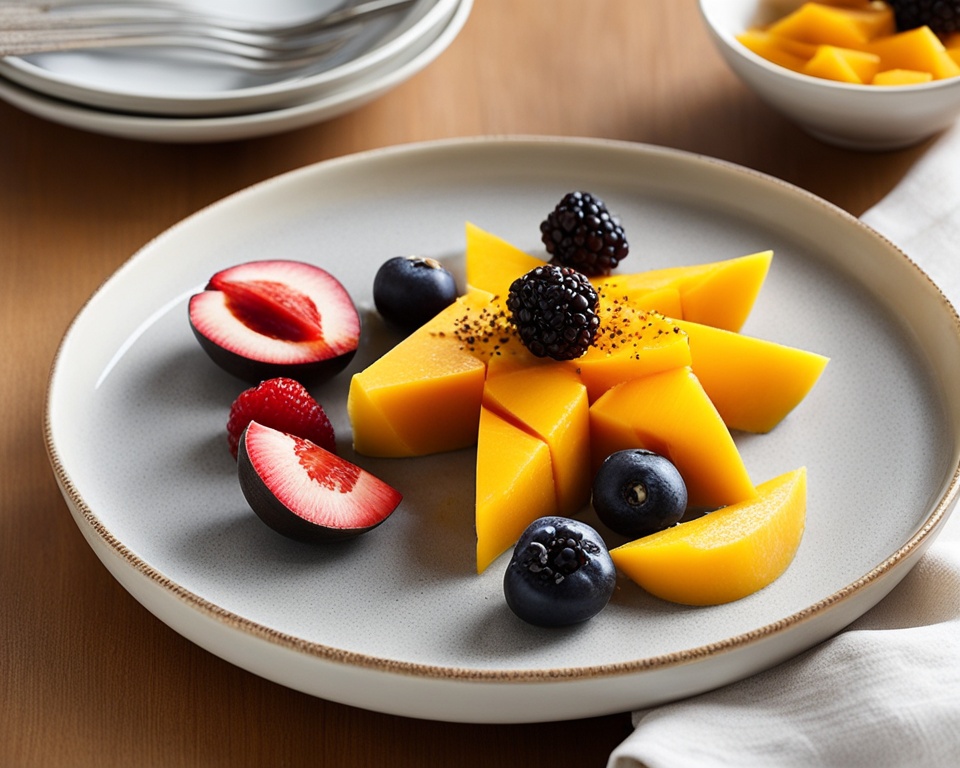
Mango Slicing Techniques
| Technique | Description |
|---|---|
| Downward Stroke | Slice off the mango skin using long, downward strokes. |
| Pit Removal | Cut the mango lengthwise on either side of the pit, creating two halves. |
| Thin Slices | Slice each mango half into thin, even slices. |
| Fan Arrangement | Create a fan-like arrangement with the mango slices by making small cuts without cutting all the way through and gently fanning out the slices. |
Mastering the art of slicing and plating the mango will not only make your mango sticky rice dessert visually appealing but also enhance the overall dining experience. Take your time, follow these tips, and enjoy creating a stunning presentation that will impress your family and friends.
Serving and Enjoying Mango Sticky Rice
Now that your delicious mango sticky rice is ready, it’s time to serve and savor this delectable dessert. Mango sticky rice is traditionally enjoyed at room temperature or slightly chilled, allowing the flavors to fully develop and mingle.
To create an enticing presentation, start by spooning a generous portion of the sticky rice onto a plate or shallow bowl. This sweet and sticky rice forms the foundation of the dish, providing a comforting base for the other elements.
Next, it’s time to layer on the succulent mango slices. Carefully arrange the ripe mango pieces on top of the sticky rice, creating a beautiful contrast between the vibrant yellow fruit and the snowy white rice. The sweetness of the mango perfectly complements the richness of the rice.
For an extra touch of flavor and texture, consider garnishing your mango sticky rice with a sprinkle of toasted sesame seeds or coconut flakes. The nuttiness of the sesame seeds and the subtle sweetness of the coconut flakes add another layer of deliciousness to this heavenly dessert.
“The combination of the soft, sticky rice, the juicy mango, and the creamy coconut sauce creates a delightful symphony of flavors and textures that is simply irresistible.” – Mango Lover Magazine
Now that your mango sticky rice is plated and garnished, it’s time to dig in and enjoy. Take a moment to admire the beautiful arrangement of colors and textures before taking your first bite.
As you savor each mouthful, you’ll experience the delicate sweetness of the sticky rice, the lusciousness of the mango, and the creamy richness of the coconut sauce. The blend of these flavors creates a harmonious balance that will surely leave you craving for more.
Remember, mango sticky rice is best enjoyed slowly, allowing yourself to fully appreciate the combination of tastes and textures with each spoonful. Share this delightful dessert with loved ones or indulge in it all by yourself, relishing every bite until the last morsel is gone.
With its irresistible flavor and unique combination of ingredients, mango sticky rice is a dessert that will leave an unforgettable impression. Whether you’re a fan of Thai cuisine or simply love indulging in sweet treats, this classic Thai dessert is sure to satisfy your cravings.
Variations and Additions
While the classic mango sticky rice recipe is delightful on its own, there are various ways to elevate it even further. Let your creativity shine and experiment with these delicious variations and additions to take your mango sticky rice to the next level:
1. Coconut Sauce Drizzle
A drizzle of coconut sauce adds a creamy sweetness to mango sticky rice.
Enhance the flavors of your mango sticky rice by drizzling a generous amount of homemade coconut sauce over the rice and mango slices. The creamy and sweet coconut sauce beautifully complements the sticky rice and adds an extra layer of indulgence.
2. Coconut Ice Cream
Elevate your mango sticky rice experience by serving it with a scoop of coconut ice cream on the side. This delightful combination of flavors and textures takes the dessert to a whole new level. The cold and creamy coconut ice cream pairs perfectly with the warm and sticky rice, creating a harmonious taste sensation.
3. Toasted Sesame Seeds
Add a nutty and aromatic element to your mango sticky rice by sprinkling it with toasted sesame seeds. The crunchy texture and subtle nuttiness of the sesame seeds provide a delightful contrast to the softness of the mango and rice.
4. Mango Coulis
Create a vibrant and tangy twist by drizzling homemade mango coulis over your mango sticky rice. The fresh and fruity flavor of the coulis enhances the natural sweetness of the mango and adds a refreshing touch to the dish.
These are just a few ideas to inspire you to customize your mango sticky rice and create a dessert that suits your taste preferences. Let your imagination run wild and explore different flavor combinations to make this classic Thai dessert truly your own.
Mango Sticky Rice Around the World
Mango sticky rice, a beloved and authentic Thai dessert, has transcended its origins and gained popularity around the world. This delightful combination of fresh mangoes and sticky rice can now be found on the menus of many international restaurants, catering to dessert lovers who crave the unique flavors and textures it offers.
With its sweet and fragrant mangoes, perfectly cooked sticky rice, and creamy coconut sauce, mango sticky rice has captured the hearts and taste buds of people from different cultures and backgrounds. The dish’s simplicity and natural sweetness make it appealing to a wide range of palates, while its vibrant colors and inviting presentation further add to its allure.
As mango sticky rice has made its way onto the global culinary scene, chefs and home cooks alike have experimented with different variations and interpretations of the classic recipe. Some have incorporated modern twists, such as adding a hint of lime zest or garnishing with fresh mint leaves, while others have combined it with other popular desserts to create new and exciting flavors.
Quotes:
“Mango sticky rice is a delightful dessert that beautifully showcases the harmony of flavors and the richness of Thai cuisine.” – Chef Somchai, Thai Kitchen
“I love how mango sticky rice brings together the sweetness of ripe mangoes and the stickiness of the rice. It’s such a comforting and satisfying dessert.” – Food Blogger, Tasty Treats
Whether you’re enjoying mango sticky rice in a bustling Thai street market or savoring it in a fine dining establishment halfway across the world, its undeniable appeal remains the same. The combination of tropical fruit, starchy rice, and creamy sauce creates a unique and irresistible dessert experience that continues to captivate dessert enthusiasts everywhere.
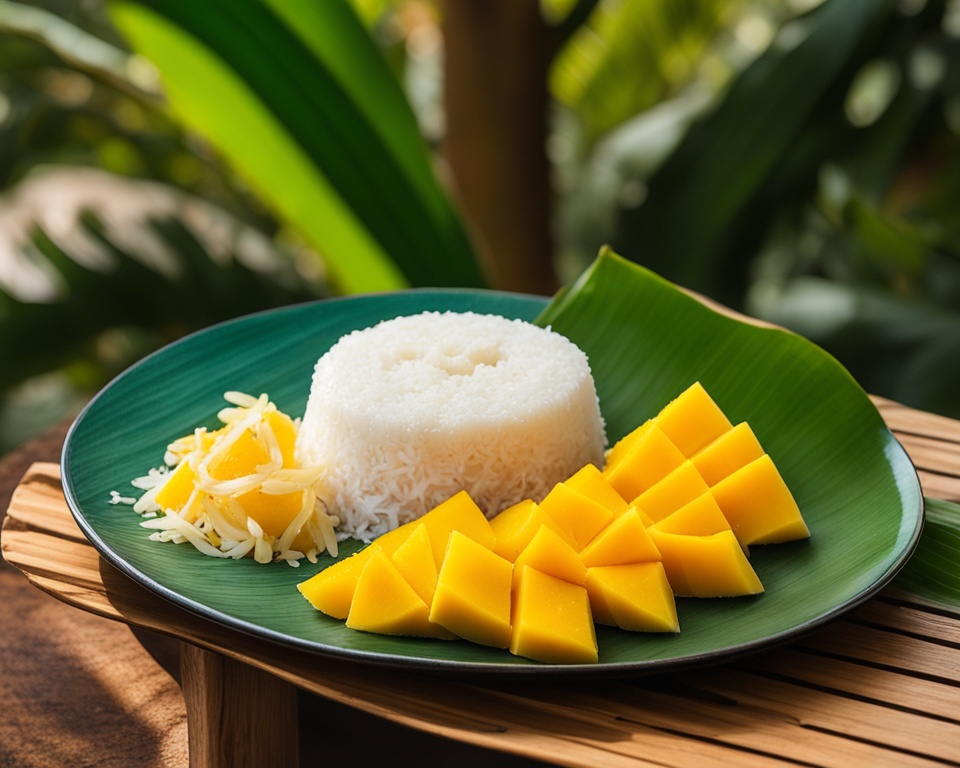
Tips for Perfect Mango Sticky Rice
Creating the best mango sticky rice requires some insider tips and tricks. Follow these guidelines to achieve a perfectly delicious dessert every time.
1. Choose the Best Mangoes
For the ultimate mango sticky rice experience, select ripe and fragrant mangoes. Look for mangoes that are slightly soft to the touch, indicating that they are perfectly ripe and juicy. The sweetness and flavor of the mango will greatly enhance the overall taste of your dish.
2. Opt for Sticky Rice
Using the right type of rice is crucial for achieving the desired sticky texture. Opt for sweet sticky rice, also known as glutinous rice, which can be found in Asian grocery stores. This rice variety is essential as it gives the dish its signature consistency.
3. Soak and Steam the Rice
Before cooking the sticky rice, it needs to be soaked in water for a few hours or overnight. This process allows the rice to soften, ensuring a tender and sticky final result. After soaking, steam the rice until it becomes soft and sticky. This step is essential for achieving the perfect texture.
4. Make a Creamy Coconut Sauce
The coconut sauce is a key component of mango sticky rice, adding a creamy and sweet touch to the dish. To make the sauce, combine coconut milk, sugar, and a pinch of salt in a saucepan. Heat the mixture until the sugar is dissolved, then let it cool before serving.
5. Slice and Serve with Style
When it’s time to plate the dish, slice the mangoes into thin strips and arrange them alongside the sticky rice. This presentation adds visual appeal and enhances the eating experience. You can also garnish with fresh mint leaves or sprinkle some toasted sesame seeds for an extra touch of flavor.
Pro Tip: Place a small bowl of extra coconut sauce on the side, allowing your guests to drizzle it over their mango sticky rice as desired.
6. Enjoy Fresh and at Room Temperature
Mango sticky rice is best enjoyed fresh and at room temperature or slightly chilled. The flavors and textures are most vibrant when the dessert is freshly prepared. Keep any leftovers refrigerated in an airtight container and consume within a day or two.
| Tips for Perfect Mango Sticky Rice | Benefits |
|---|---|
| Choose the Best Mangoes | – Enhances the flavor of the dish – Provides natural sweetness – Juicy and aromatic |
| Opt for Sticky Rice | – Gives the dish its signature consistency – Creates the desired sticky texture |
| Soak and Steam the Rice | – Softens the rice for tenderness – Achieves the perfect sticky texture |
| Make a Creamy Coconut Sauce | – Adds a creamy and sweet touch – Complements the mango and rice flavors |
| Slice and Serve with Style | – Enhances presentation and visual appeal – Adds texture to each bite |
| Enjoy Fresh and at Room Temperature | – Optimizes flavors and textures – Best experience when freshly prepared |
Frequently Asked Questions (FAQ)
Preparing mango sticky rice can be a delightful experience, but it’s natural to have some questions or concerns along the way. In this section, we’ll address some common queries and provide you with all the answers you need to create a delicious mango sticky rice recipe.
1. Can I substitute regular rice for sticky rice in the recipe?
While sticky rice is essential for achieving the authentic texture of mango sticky rice, you can experiment with other types of rice if sticky rice is not available. However, keep in mind that the end result may differ in consistency and taste.
2. How should I store leftover mango sticky rice?
Store any leftover mango sticky rice in an airtight container in the refrigerator. It can be enjoyed within 2-3 days if properly stored. Before serving the leftovers, gently reheat the rice in a microwave or a steamer to restore its softness.
3. Can I freeze mango sticky rice?
Freezing mango sticky rice is not recommended as it can alter the texture and taste of the dish. It’s best enjoyed fresh or within a few days of preparation.
4. How can I reheat mango sticky rice?
To reheat mango sticky rice, transfer it to a microwave-safe dish and heat it in short intervals, stirring in between, until it reaches the desired temperature. Alternatively, you can steam the sticky rice over boiling water until it warms up.
5. Can I add other fruits to the recipe?
While mangoes are the traditional fruit used in mango sticky rice, you can experiment with other fruits such as strawberries, peaches, or bananas. Ensure that the fruits complement the flavors of the dish and maintain their texture when combined with the sticky rice.
6. Can I make mango sticky rice vegan-friendly?
Absolutely! You can make a vegan version of mango sticky rice by substituting the traditional coconut milk with a plant-based alternative such as coconut cream or almond milk. Just be sure to choose a dairy-free milk that suits your preferences and dietary needs.
7. Can I add toppings to my mango sticky rice?
Yes, you can enhance the visual appeal and flavor of your mango sticky rice by adding toppings. Some popular options include toasted sesame seeds, crushed peanuts, or a sprinkle of coconut flakes. Get creative and experiment with different combinations to find your favorite!
8. Can I serve mango sticky rice warm?
Mango sticky rice is traditionally enjoyed at room temperature or slightly chilled. However, if you prefer a warmer dessert, you can gently heat the sticky rice before serving. Just be mindful not to overheat the mango slices, as they can become mushy.
With these frequently asked questions answered, you’re now equipped with the knowledge to create a perfect mango sticky rice recipe. Feel free to explore variations, adapt the recipe, and enjoy this delightful Thai dessert to the fullest!
Exploring Other Thai Desserts
Thailand is renowned for its rich culinary heritage, offering a wide array of delectable dishes and desserts that delight food enthusiasts around the world. While mango sticky rice holds a special place in Thai cuisine, there are numerous other authentic Thai desserts that are equally popular and worth trying.
1. Tub Tim Grob
Tub Tim Grob, also known as “red rubies,” is a beloved Thai dessert that combines sweetened water chestnut rubies with coconut milk and ice. The chestnuts are infused with vibrant red color and possess a delightful crunch, providing a refreshing and flavorful treat on a hot day.
2. Khanom Chan
Khanom Chan is a traditional Thai layered dessert made from rice flour and coconut milk. This delicacy features colorful layers, each with a unique flavor such as pandan, coconut, or taro. The smooth and creamy texture makes Khanom Chan a delightful and visually appealing dessert.
3. Thong Yib
Thong Yib, also known as “golden egg yolks,” is a popular Thai dessert made from egg yolks, sugar, and flour. These bite-sized treats are delicately shaped into intricate flower-like designs and then deep-fried until golden brown. Thong Yib offers a delicate balance of sweetness and a satisfying crunchy texture.
4. Sticky Rice with Mango and Coconut Cream
Sticky Rice with Mango and Coconut Cream is another Thai dessert that showcases the perfect combination of flavors. It features sweet sticky rice topped with ripe mango slices and drizzled with creamy coconut cream. This dessert offers a harmonious blend of sweet, creamy, and tropical flavors that will transport you to the exotic streets of Thailand.
| Dessert | Description |
|---|---|
| Tub Tim Grob | A refreshing dessert made with sweetened water chestnut rubies, coconut milk, and ice. |
| Khanom Chan | A layered rice flour dessert with colorful and flavorful coconut and pandan layers. |
| Thong Yib | Deep-fried delicacies made with egg yolks, sugar, and flour, featuring intricate flower-like designs. |
| Sticky Rice with Mango and Coconut Cream | A classic Thai dessert consisting of sweet sticky rice, ripe mango slices, and creamy coconut cream. |
Exploring these traditional Thai desserts allows you to experience the diverse and vibrant flavors that Thai cuisine has to offer. Whether you have a sweet tooth or simply enjoy discovering new culinary delights, these authentic Thai desserts are sure to satisfy your cravings and leave a lasting impression.
Conclusion
In conclusion, mango sticky rice is an irresistible and authentic Thai dessert that can be easily prepared in the comfort of your own kitchen. By following our step-by-step guide and incorporating the tips and tricks we’ve shared, you’ll be able to create the best mango sticky rice and indulge in its delicious flavors.
Whether you’re a fan of Thai cuisine or simply looking to try something new, this classic dessert is sure to impress both your taste buds and your guests. The combination of sweet and sticky rice with ripe mango creates a delightful balance of flavors and textures that will leave you craving for more.
So why wait? Grab some ripe mangoes, sticky rice, and coconut milk, and get ready to embark on a culinary adventure with mango sticky rice. Whether you enjoy it as a refreshing summer dessert or as a comforting treat during any season, this traditional Thai delight is bound to become a favorite in your household.
